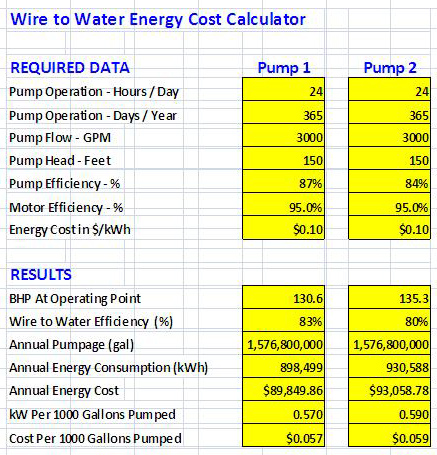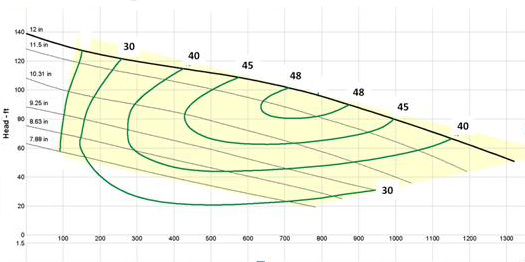Editor's Note: This is the sixth in a six-part series on centrifugal pump efficiency. For other articles in this series, click here.
The power required by a pump is directly proportional to both the flow and the head that it produces. As flow and/or head increase(s) so does the power required. Conversely, power is inversely proportional to hydraulic efficiency. For the same flow and head, an increase in efficiency reduces the power requirement. The two equations below illustrate this relationship:
|
P = (Flow x Head) / Ef |
| BHP = ((Flow x Head) / 3960) / Ef |
|
Where: |
|
P = Hydraulic power |
| BHP = Brake horsepower |
| Ef = Pump efficiency |
Pumps that run continuously or for extended periods can experience a substantial reduction in energy costs with a relatively small increase in efficiency. Figure 1 shows two, 3,000-gallon-per-minute pumps that operate 24/7. With efficiencies of 87 percent and 84 percent, the horsepower required is 130 and 135 respectively. The electrical cost per thousand gallons is 5.7 and 5.9 cents. Two-tenths of a cent is not a huge difference, but if you consider the annual cost of electricity, the lower efficiency pump adds an additional $3,200 to the total electric bill.
 |
| Figure 1. The wire-to-water information for two, 3,000-gallon-per-minute pumps that operate 24/7 |
Another factor that can increase the attractiveness of higher efficiency is the cost of electricity. The energy cost of 10 cents per kilowatt hour, used in Figure 1, is the average commercial rate for 2010. However, it can vary significantly by state.
In some states, the cost of electricity can be as low as 6 cents, and in certain parts of Washington, cooperative rates can be as low as 4 cents. New England states’ costs, however, are in the high teens. What is the worst case? Hawaii—with Oahu at 23 cents and some outer islands topping out near 40 cents.
As the cost per kilowatt hour increases, so will the savings due to increased pump efficiency. Seeing what the average rates will be for 2011 will be interesting. I suspect that they have increased substantially. Another factor to consider when selecting a pump that will not run continuously is the actual flow rate required. Does the end user really need 3,000 gallons per minute, or can the same results be achieved by running a 2,000-gallon-per-minute pump longer?
If you have the same head and efficiency at these two flow rates, the cost per thousand gallons pumped is the same for both. In most cases, reducing flow by 1,000 gallons per minute will result in a substantial decrease in friction head. Since BHP is directly proportional to head, an end user could see a substantial reduction in the cost per thousand gallons pumped with the lower volume pump.
 |
|
Figure 2. The H/Q curve for a 4-inch, vortex wastewater pump |
When Is Efficiency Not As Important?
Selecting the most efficient pumps and motors will always reduce the cost of electrical power, but sometimes, the payback versus initial cost does not pencil out. Examples include smaller pumps, pumps that are used infrequently and those installed for back-up or emergency use only.
In many industrial applications, efficiency will take a back seat to a pump’s ability to reliably perform a particular process. A good example is a slurry pump, with which larger clearances increase useful life. Another is the vortex pump, which is popular in both industrial and wastewater applications.
Figure 2 shows the H/Q curve for a 4-inch, vortex wastewater pump. At 800 gallons per minute, its hydraulic efficiency is just 48 percent. A standard 4-inch, non-clog pump with similar performance would have an efficiency of 68 to 75 percent—20 to 27 points better. The reason for the lower efficiency is that vortex action is a two-step process, and the overall efficiency is the product of the two individual efficiencies. However even though efficiency is much lower than normally desired, there is an extremely positive side. Almost anything that enters the suction of a vortex pump will exit its discharge.
This is because the vortex impeller is recessed and seldom contacts any of the solids or other material in the pumpage. This can be beneficial when smaller wastewater pumps are required. The more efficient 4–inch, non-clog pump can plug frequently when rags and stringy material are present, and this often results in removing the pump from service for cleaning on a weekly basis.
In these applications, a vortex pump can be far more reliable, and the maintenance cost savings is much greater than the additional energy costs due to lower efficiency. One of the seminars I present to specifying engineers is titled “How Lower Pump Efficiency Can Reduce Costs.” It usually gets their attention.
If a pump is run by a gasoline engine, the case could be made that the pump’s efficiency is not too important. Although an 80 percent efficient pump should save quite a bit of energy over one that is 65 percent efficient, the gas engine (approximately 20 percent) brings their totals down to 16 percent and 13 percent respectively.
It may be hard to justify a higher initial pump cost for such a small energy savings, unless the pump is used frequently and for long periods of time.
Finally, some application design points exist for which reasonable efficiency cannot be attained, but a pump is still required. Suppose some million-dollar process line cannot use a positive displacement pump but, instead, requires a centrifugal pump that can deliver 20 gallons per minute at 3,000 feet of head.
Would it really matter if a single-stage pump had to be driven at 23,000 rpm and that its efficiency was less than 25 percent? Probably not, and there are far more of these types of applications than you might suspect.
There is definitely more than one side when it comes to pump efficiency. Efficiency is a good thing, and we should always consider a higher efficiency pump if the return on investment pencils out.
Often, a peak efficiency that adds one or two percentage points is not that important since few pumps operate at their best efficiency points (BEPs). The breadth of high efficiency, on either side of BEP, can be far more beneficial.


